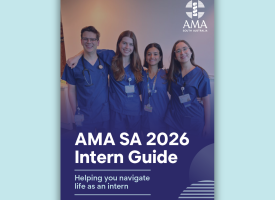Clinical Support Time for Public Hospital Doctors - 2009
AMA Position Statement: Clinical support time for public hospital doctors - 2009 The AMA defines clinical support time as protected time for duties that are not directly related to individual patient care. Clinical support duties encompass most aspects of the teaching, continuing professional development, clinical governance, administration and research activities undertaken by clinicians in the public health sector. The purpose of this position statement is to specify a minimum benchmark of remunerated time for clinical support duties for senior and junior clinicians. It includes a comprehensive list of the roles and responsibilities that constitute clinical support time to assist with developing job descriptions and work schedules.
Introduction
The AMA defines clinical support time as protected time for duties that are not directly related to individual patient care. Clinical support duties encompass most aspects of the teaching, continuing professional development, clinical governance, administration and research activities undertaken by clinicians in the public health sector.
The purpose of this position statement is to specify a minimum benchmark of remunerated time for clinical support duties for senior and junior clinicians. It includes a comprehensive list of the roles and responsibilities that constitute clinical support time to assist with developing job descriptions and work schedules.
Background
Clinical support time is variously termed “non-clinical time” or “other professional duties”. The AMA uses the term clinical support time as it best describes the range of activities undertaken by clinicians that are not directly related to the diagnosis or management of individual patients and that aim to enhance the quality of care.
It is estimated that clinicians should spend at least 30 per cent of their working time on clinical support activities. These include:
- teaching and supervising,
- designing work and training programs,
- preparing reports, references and rosters,
- participating in staff appraisals,
- maintaining and/or improving professional skills relative to the individual’s level, and
- conducting quality audits and clinical reviews.
A list of clinical support duties is at Annex A.
The AMA consulted with the medical colleges in 2008 and received broad support for an overall benchmark of 30 per cent for clinical support time. The colleges’ support was based on their recognition that protected time for teaching and supervising medical students and trainees, and for continuing professional development, is essential for senior and junior clinicians. Clinical support duties are an integral component of clinical practice and are included in the CanMED competencies identified by the Australian Medical Council as an essential part of the curricula of the medical colleges.
Provisions for clinical support time in industrial agreements for salaried doctors vary between the Australian jurisdictions. Most existing agreements do not explicitly recognise clinical support time or specify a minimum benchmark. It is difficult for clinicians to access quality protected time for these activities and to avoid working in excess of the hours for which they are paid.
Public hospitals rely heavily on the clinical support roles performed by clinicians to maintain their day-to-day operations. Adequate clinical support time is crucial for enabling quality teaching, the sustainability of clinicians’ professional practice and for the capacity of the public health sector to provide quality care to patients.
Teaching and training
The AMA recognises that many clinicians do not choose to work in the public health sector for the financial rewards but to serve the community and to train the next generation of doctors. The majority of undergraduate and postgraduate clinical teaching is undertaken by clinicians on a pro-bono basis.
Protected time for clinical teaching and training is an important incentive for full-time clinicians who provide training to more junior levels. It contributes to the retention of these doctors, and the teaching resource that they represent, in the public health sector. Similarly, providing time and resources for continuing professional development and research activities are vital for vocational and life-long learning and high-quality and efficient care.
Training the next generation of doctors will be a huge challenge for the medical profession because of increasing number of medical students and subsequent numbers of prevocational and vocational trainees. Teaching and supervising students and trainees are key activities for clinicians and represent a significant component of their professional time.
The demand on clinicians to ensure that students and trainees are adequately skilled and meet medical board and college training and supervisory requirements will grow in line with the number of medical graduates entering the public health sector. All clinicians need time for teaching in addition to, and separate from, personal professional development time. Time needs to be protected from the competing pressures of immediate clinical service delivery to ensure that the quality and effectiveness of teaching are not compromised. This includes time to prepare for teaching, to maintain teaching skills or for the trainee to be personally supervised and reviewed. The availability and extent of clinical supervision have serious implications for the quality of patient care.
AMA Position
- The health jurisdictions must increase their awareness of the critical importance of clinical support time to the functioning of a quality health service. Clinical support time is not optional and provides the opportunity for clinicians to carry out core professional activities and be properly trained,
- The health jurisdictions should support the inclusion of clinical support time in job descriptions and staffing models for all posts. This will improve job satisfaction and morale in the public health sector, assist with recruiting and retaining staff and improve the efficiency and quality of care,
- The demands on clinicians to undertake teaching, administrative and other clinical support duties in the public health sector are increasing as the demand for clinical services grows. Their responsibilities will become unmanageable unless employment provisions explicitly recognise and allocate time for the duties that are not directly associated with the diagnosis or management of individual patients, and
- 30 per cent of ordinary remunerated time should be the minimum benchmark for clinical support time for clinicians. This is to cover the activities included in Annex A. Clinicians with formal management responsibilities as head of department or in other senior roles, and those who are supervisors of training, should have an additional allocation of time for these roles. Locums require clinical support time commensurate to the clinical duties undertaken.
A list of the activities and responsibilities appropriately undertaken during clinical support time is at Annex A.
See also:
AMA Position Statement Prevocational Medical Education and Training 2005.
Annex A
Clinical support duties for public hospital doctors
Teaching and training
For senior clinicians
Supervision and oversight of doctors-in-training and undergraduate medical students
Teaching activities for undergraduate, prevocational, vocational and allied health students
Teaching activities include lectures, case presentations, workshops, grand rounds and associated preparation time
In-training assessment activities, including feedback sessions with doctors-in-training
Maintenance and improvement of teaching skills
For residents and registrars:
Supervision and oversight of doctors-in-training and undergraduate medical students
Protected training time for attendance at tutorials, lectures, workshops and conferences
Examination preparation time
In-training assessment activities, including feedback with clinical supervisors
Teaching activities for undergraduate and vocational students
Teaching activities, including lectures and case presentations, grand rounds and associated preparation time
Continuing professional development
Attendance or presentation at departmental and regional continuing education sessions
Attendance or presentation at local and international conferences and workshops
Journal clubs
Peer review
Self-directed continuous learning activities including reading and review
Maintenance of professional standards
Specialty college activities including board, committee and examination work
Professional body activities at state and national level
Participation on government and non-government boards and committees
Audit & quality assurance
Audit and appraisal activities at individual, departmental and hospital levels
Quality assurance activities, including collection, analysis and presentation of clinical data
Peer review
Morbidity, mortality and critical incident review
Clinical credentialling (delineation of clinical privileges) activities
Occupational health and safety
Personal participation in programmes to safeguard health and wellbeing
Development and supervision of OH&S programs for co-workers
Research
Clinical trials and studies
Laboratory-based research
Reading time
Preparation time
Collaboration time
Health care liaison
Non-patient contact including liaison with carers, relatives and other health professionals
Administrative
Rostering
Committee work at hospital, government and community levels
Administrative paperwork and communication
Data collection and report preparation to meet hospital or government requirements and requests
Managerial
Human resource management
Financial resource management
Clinical pathway development and implementation



